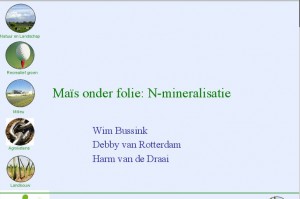Summary of the results Manganese and Boron 2011
Click here for the report:
Manganese Boron
Objective: Can the availability of manganese and boron in the soil be determined more precisely to achieve improved fertilizer recommendations.
Several soil samples and parameters have been analysed during this study. The most relevant results can be seen in tables 1,2 and 3. The results show that the soluble fraction of Boron (say readily available) average approximately 3% of the total B amount present in the soil (with a range of 1.2%-10%) whereas the total of reactive B (say the amount that can be post-delivered) averaged 9% of the total amount of Boron present in the soil.
The soluble fraction was also low in the case of Manganese, ca 5% but the range was much greater. The lowest values were found in Kooiker in Grijpskerk, where the soluble fraction was only 0.04% of the total (the reason for this is the high pH of the soil). On the other hand, the highest fraction of Manganese was found at Van Emst, Tijnje; 17.34% (this soil has the lowest Ph value and a fair amount of organic matter). The total reactive values for Manganese will be considered in more detail as it is likely that the standard methods used in the lab (0.43M HNO3 extraction) are not adequate for this particular metal. A new method of determination is considered as a replacement to traditional chemical analysis.
In figure 1 the correlation between the amount of soil soluble Manganese and the concentration in the plant tissue can be seen. There is a clear positive relationship but with an R2 value of 0.42 it remains only an indication and no firm conclusions can be drawn. In the case of Boron, (figure 2) there is no clear correlation between the soluble Boron in the soil versus the concentration in the plant tissue. We can see that similar amounts of soluble Boron were found in the plant tissue with different amounts of soluble Boron in the soil. This is an indication that the inclusion of Boron is not determined by the amount of soluble Borum in the soil.
*Note Leeraar, projectleader Maize under film 2009-2011: Boron as stated on the current soil survey concerns the water soluble portion of Boron. So readily available to the plant. Firstly, a significant safety margin is applied. Secondly, there is no direct correlation with low values when strewn. Possibility is that the reactive amount of Boron (post-delivery dose during the growing season) has a high value. Currently this has not (yet) been researched.
**For questions on this article, please contact Dr. W. Bussink, NMI Wageningen, mentor of this research








